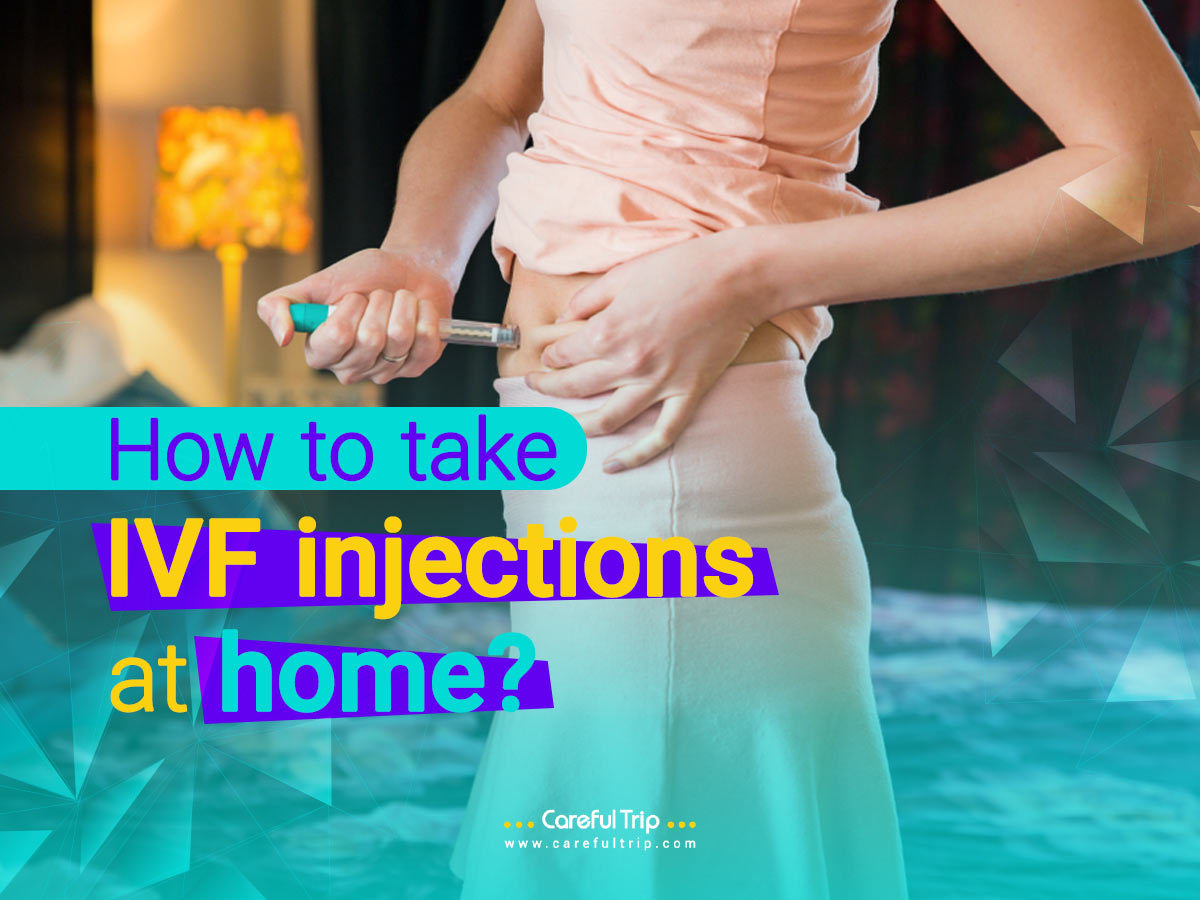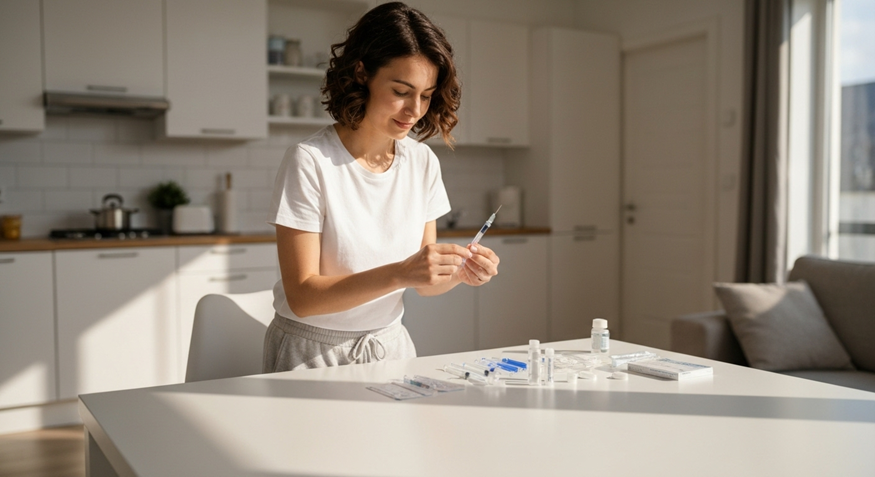
How to Take IVF Injections at Home?
IVF injections at home are a crucial part of the fertility treatment process known as in vitro fertilization. Although administering these injections can seem difficult at first, it can be done safely and efficiently with the right planning, skill, and assistance. Proper medicine administration is essential for the IVF cycle, and understanding your menstrual cycle is vital for success. Patients can ensure they are well-prepared by knowing the stages of the process, including the transfer to the uterus, and adhering to best practices.
Intrauterine growth factor (IVF) injections, including IVF shots, are essential to stimulate the ovaries through a series of injectable medications. These medications generate many eggs, delay premature ovulation, and support the uterine lining for embryo implantation. Common injectable medications include progesterone, hCG triggers, trigger shots, GnRH agonists/antagonists, and gonadotropins. Each drug serves a distinct function and is administered at various points during the IVF cycle, making it important for patients to familiarize themselves with the process of IVF injections at home to enhance their chances of success.
We have talked about these IVF injections at home at length in our previous articles, but administering them is another matter. When storing your IVF medications and injections at home, always refer to the storage instructions provided with each specific drug. Many IVF medications, such as gonadotropins and certain hCG triggers, require refrigeration at a temperature between 2°C and 8°C, while others like progesterone may be stored at room temperature. Ensure all medications are kept in their original packaging, away from light and moisture, and out of reach of children. If you are ever unsure, consult your healthcare provider or pharmacist for guidance.
Many patients find that administering IVF injections at home is really convenient, as it enables them to continue with their regular activities without having to make frequent journeys to the clinic. However, administering IVF injections, especially the first injection, which is a crucial part of the process leading to embryo transfer, necessitates a thorough understanding of the procedures to minimize discomfort and lower the chance of any problem occurring. In this article, we have tried to provide a thorough explanation of giving IVF injections at home, with particular attention to the question of which area to inject—the thigh or the stomach. Additionally, we recommend consulting detailed instructional videos to ensure proper techniques are followed.
Types of Fertility IVF Injections

Although we have gone in depth in detailing different types of IVF injections, let’s revisit the types of IVF medications that require daily injections to support egg development, for which a small drop of medication may be necessary. For those administering IVF injections at home, it is essential to understand these medications to ensure proper support during your treatment. Here is a quick breakdown of the different types:
For those considering international health tourism for IVF treatments, it’s worth noting that there are international health tourism companies that offer 24/7 care coordination and consultation services. These companies often help patients manage the entire process, including medication schedules, appointments, and follow-up consultations, ensuring support is always available during your IVF journey. With the availability of such services, patients can feel more confident about administering their IVF injections at home.
● Gonadotropins:
- Purpose: Stimulate the ovaries to produce multiple eggs.
- Common Medications: Menopur, Follistim, Gonal-F.
- Duration: Typically administered daily for 8-14 days.
● GnRH Agonists and Antagonists:
- Purpose: Prevent premature ovulation and control hormone release.
- Common Medications: Lupron (agonist), Cetrotide, and Ganirelix (antagonists).
- Duration: Agonists can be used daily for 10-14 days before stimulation and during stimulation; antagonists are used from the fifth or sixth day of stimulation until the hCG trigger.
● Human Chorionic Gonadotropin (hCG):
- Purpose: Trigger the final maturation of the eggs.
- Common Medications: Ovidrel, Pregnyl.
- Timing: Administered once, about 36 hours before egg retrieval.
● Progesterone:
- Purpose: Prepare the uterine lining for implantation and support early pregnancy, including monitoring through ultrasounds and blood tests, with a focus on the timing of the trigger shot.
- Forms: Intramuscular injections, vaginal suppositories.
- Duration: Typically starts with the administration of the trigger shot the day after egg retrieval and continues for 10-12 days or until the pregnancy test. If pregnancy is confirmed, it may continue for up to 10 weeks.
For more information, read:
Preparation for IVF Injection at Home with a Syringe
For patients to administer injections for the IVF treatment at home, they have to follow certain steps:
- Gather Supplies: Make sure you have the medicine, syringes, alcohol swabs, a sharps container for used needles, and any other items your healthcare professional has advised on a clean, flat surface on hand.
- Clean Hands and Area: Wash your hands well with soap and water. Thoroughly clean the injection site with an alcohol swab and allow it to dry.
- Mix Medication (if Needed): Prior to usage, certain IVF medications must be blended. Observe the directions on your prescription or from your medical professional.
Steps for Administering Injections
- Draw Medication: If you’re using a syringe, fill it with the recommended dosage, making sure there are no air bubbles.
- Choose the Injection Site: Select the area of your thigh or stomach (abdomen) based on comfort and advice from your healthcare practitioner.
IVF Injections: Stomach or Thigh
IVF injections, like any injection, should follow a set of protocols and steps. Which are:
Stomach (Abdomen)
- Site Selection: Select a location that is about 1-2 inches away from the belly button, below the navel, but above the hip bones, ensuring it includes sufficient fatty tissue for effective absorption—this process can quickly become second nature. Remember to dispose of your needle and syringe in a proper sharps container immediately after injection.
- Pinch Skin: To give the injection a harder surface, gently pinch a flap of skin between your thumb and fingers.
- Insert Needle: Grasp the syringe like a pencil, then poke the needle directly into the pinched skin at a 90-degree angle, ensuring the syringe is properly filled from a vial after carefully removing the needle cover.
- Inject Medication: To inject medication, slowly and steadily press the plunger.
- Remove Needle: Release the squeezed skin by withdrawing the needle at the same angle that it was inserted.
- Apply Pressure: For a few seconds, gently press the injection site with a clean cotton ball or piece of gauze.
Thigh
Injecting the thigh follows the general steps of injecting the stomach. First, you have to select the site of injection, which is, in this case, on the front of the thigh, midway between the knee and hip, on the outer aspect. It’s also important to prepare a clean, flat surface. Pinch the skin, insert the needle, and then inject the medication slowly and steadily. Afterward, just remove the needle and let go of the pinched skin while applying pressure on the injection site, letting go of the pinched skin.
IVF Injections Schedule
When it comes to managing IVF injections, maintaining a consistent schedule is crucial. Most patients are required to administer daily injections, which typically begin on day two or three of their menstrual cycle. The first injection marks an important milestone in the IVF process, setting the stage for the subsequent stages of the treatment. Following your healthcare provider’s specific instructions regarding timing is essential, as even slight deviations can impact the effectiveness of the treatment. It’s recommended to use a medication log or app to track your daily injections and any necessary blood tests, helping to ensure you stay on schedule throughout your IVF cycle.
During the IVF cycle, the injection schedule may vary depending on the types of medications being used and the individual patient’s response to treatment. For instance, some may require one injection daily, while others may need to take multiple injections at different times of the day. Your healthcare provider will closely monitor your progress through regular blood tests and ultrasounds, checking for essential factors such as sperm and hormone levels, to adjust the schedule as necessary. Adhering to your injection schedule not only helps in achieving the desired hormone levels for egg retrieval but also plays a vital role in improving the chances of a successful pregnancy.
How Long Do You Take IVF Injections?
The length of IVF injections can vary significantly from person to person, usually lasting between eight and fourteen days. Some patients might need to inject for up to three weeks, depending on their response to the medication and their specific treatment plan. The first phase typically begins with ovarian stimulation, during which medications are administered to encourage the development of multiple follicles. Ultrasounds are used to monitor progress.
After egg retrieval, patients may continue with different injections to support embryo transfer and implantation. These medications are vital in preparing the uterine lining for a possible pregnancy and may be continued for several weeks. Regular blood tests help your healthcare team determine the best timing for adjusting medications and ensure the treatment meets your body’s needs. It’s essential to stay in touch with your healthcare provider to understand what to expect during this part of IVF treatment.
Managing IVF Injections with a Busy Work/Life Schedule
Managing IVF injections while juggling a busy work and life schedule can feel overwhelming, but with a few strategic approaches, it can be made more manageable. First, it’s essential to understand the injection schedule thoroughly. Marking appointments on your calendar or setting reminders on your phone can help keep you on track. Consider organizing your supplies the night before by laying out the syringes, medications, and any necessary accessories, so that when it’s time to inject, you won’t have to rummage through cabinets. You may also want to discuss your schedule with your healthcare provider, who can offer insights on timing adjustments or alternative injection methods that better fit into your routine. Furthermore, incorporating self-care practices like relaxation techniques before injections can ease anxiety and enhance the experience. Being open with your employer or colleagues about your IVF journey can help you manage work commitments, ensuring that you don’t overextend yourself during this crucial time.
Potential Side Effects of IVF Injections
While most people experience mild side effects from IVF injections, it’s essential to be aware of what to look for. Common side effects include localized reactions at the injection site, such as redness, swelling, and tenderness. These symptoms are typically temporary and can be managed with gentle care. However, some patients may experience more severe reactions, such as significant abdominal pain, bloating, or severe pain and mood swings, which should be reported to a healthcare provider promptly.
In rare cases, serious side effects can occur, such as ovarian hyperstimulation syndrome (OHSS), characterized by severe abdominal pain, rapid weight gain, or difficulty breathing. Recognizing the signs of serious side effects early can help mitigate risks and ensure appropriate medical intervention. Always keep your healthcare provider informed of any unexpected symptoms during your IVF treatment, as they can provide guidance and support tailored to your unique situation, including advice on the safe disposal of needles and syringes after use.
After IVF Injection at Home
Now that the injection is done, what steps should you take? Let’s find out:
- Dispose of Needles Safely: Place used needles and syringes in a sharps container immediately after use.
- Record Injection: Keep a log of your injections, including the date, time, medication, and dosage. If you have any questions about your medication, consult your pharmacy for guidance.
- Monitor for Side Effects: Watch for any signs of infection at the injection site, such as redness, swelling, or pain. Contact your healthcare provider if you experience any concerning symptoms.
Tips for Successful IVF Injections
For some, administering IVF injection, or any injection, such as subcutaneous injections, can be a daunting task. If that is the case, you should seek professional help, but in the end, you can administer your shots yourself or ask a family member for assistance. Simply follow these specific instructions and steps:
- Rotate Injection locations: Within the advised areas, rotate between various locations to prevent bruising, irritation, and soreness. Contact your pharmacy for guidance on proper injection techniques.
- Remain Calm: Try to maintain your composure and relaxation while giving the shot. Breathing deeply can be beneficial.
- Practice: If feasible, practice with a medical professional or nurse before attempting it on your own.
Final Words
IVF injections at home need to be administered with great care, precision, and emotional support to enhance your competence. Taking this crucial step ensures a more streamlined and effective operation, whether you choose to inject in the stomach or thigh. Always remember that IVF injections at home require proper technique; remove the needle cap and ask your healthcare provider for specific guidance and assistance throughout your IVF journey.
Contact us at CarefulTrip to receive your free consultation today. By linking our patients with the excellent staff at the MOM Fertility Clinic, CarefulTrip ensures that every crucial step in the fertility journey is taken care of throughout their fertility journey and that the necessary instructions, including those for using the syringe with the needle tip, are given to them.
FAQ
Is it possible to do IVF injections while out of the house?
Yes, it’s entirely possible to administer IVF injections while out of the house, but it requires careful planning. Always ensure you have your medication and supplies readily available, along with a sharps disposal container for used needles. Choose a discreet and clean location to perform the injection, and follow your regular routine as closely as possible. If you anticipate discomfort or anxiety about injecting in a public place, consider reaching out to a trusted friend or family member for emotional support. Proper preparation can help you remain confident and comfortable during your IVF treatment, even when away from home.
What supplies do I need for IVF injections at home?
To successfully administer IVF injections at home, you will need a few essential supplies. First, ensure you have your injectable medications, as prescribed by your fertility specialists or fertility specialist. Alongside these, you will also need appropriate syringes and needles to draw up and administer the medication. Alcohol swabs are crucial for disinfecting the injection site, and gauze pads will help manage any bleeding or discomfort after the injection. It’s also essential to have a sharps disposal container ready for safe disposal of used needles and syringes. If you have any questions about specific supplies, don’t hesitate to consult your pharmacy or healthcare provider.
Where on my body should I inject IVF medications?
When it comes to IVF injections, the most common injection sites are the abdomen and thigh. For abdominal injections, choose a spot that is about 1-2 inches away from the belly button, ensuring that the area has sufficient fatty tissue for effective absorption. If you opt for thigh injections, select the outer aspect of the thigh, midway between the hip and knee, which also contains fatty tissue. It’s vital to rotate injection sites within these areas to minimize discomfort and reduce the risk of bruising. Always follow your healthcare provider’s recommendations on the best injection sites for your specific treatment.
What should I do if I experience pain or discomfort during IVF injections?
Experiencing pain or discomfort during IVF shots can be concerning. If you encounter pain at the injection site, apply gentle pressure with a gauze pad and monitor for any signs of severe reactions, such as excessive swelling or redness. If discomfort persists or if you notice any serious side effects, contact your healthcare provider immediately. They can provide guidance and reassurance, ensuring that you receive the necessary support throughout your IVF journey. Emotional support from friends, family, or support groups can also help alleviate anxiety during this process.
What are the usual side effects from IVF self-injections?
IVF self-injections may lead to various side effects involving the hormones used to stimulate the ovaries and promote the development of follicles, typically mild and manageable. Common side effects include localized soreness, bruising, or swelling at the injection site. Other patients may experience systemic effects such as mood changes, fatigue, or mild abdominal discomfort as a response to the hormone medications. It’s essential to keep an open line of communication with your healthcare provider regarding these side effects. They can help you differentiate between normal responses and indications of more severe issues that may require medical attention.
How to Take IVF Injections at Home?
Taking IVF injections at home involves several steps. First, gather all necessary supplies, including the medication and alcohol swabs. Clean the injection site, draw the prescribed dose into a syringe, and inject it at a 90-degree angle. Finally, dispose of sharps safely to ensure proper hygiene and safety.
References:
